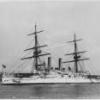Supplies of the Ship Modeler's Handbook are running out. Get your copy NOW before they are gone! Click on photo to order.
×
-
Posts
9,207 -
Joined
-
Last visited
Reputation Activity
-
 Jim Lad got a reaction from Mark Pearse in 28' Ranger-type Yacht by Mark Pearse - FINISHED - 1:12
Jim Lad got a reaction from Mark Pearse in 28' Ranger-type Yacht by Mark Pearse - FINISHED - 1:12
It's called a snatch block here too, Druxey (but maybe not if you're a yachty 😄).
Very nice setup, Mark!
John
-
 Jim Lad got a reaction from mtaylor in USS/SS Leviathan 1914 by shipmodel - FINISHED - 1/200 - troop ship/ocean liner
Jim Lad got a reaction from mtaylor in USS/SS Leviathan 1914 by shipmodel - FINISHED - 1/200 - troop ship/ocean liner
A very interesting piece of work, that camouflage, Dan. Very well executed.
John
-
 Jim Lad got a reaction from realworkingsailor in The 1864 Composite Ship 'City of Adelaide'
Jim Lad got a reaction from realworkingsailor in The 1864 Composite Ship 'City of Adelaide'
While on our recent holiday I was able to visit the ‘City of Adelaide’ in her current home at Port Adelaide, South Australia. This ship is an important relic of the past, being one of only three composite ships surviving (and the oldest one by a few years); one of only three surviving sailing ships that carried emigrants from the United Kingdom – and the only one actually built as a passenger ship; and the last surviving sailing ship from the 19th century North Atlantic timber trade.
She was built in Sunderland, England, in 1864 for Devitt and Moore, who used her to carry emigrants from England to Adelaide for twenty years. Following her days as a crack passenger ship she was involved in various trades before falling into a long decline that almost resulted in her final destruction. There is quite a comprehensive article concerning her career on Wikipedia.
In spite of her historic significance, she had been in imminent danger of being dismantled due to lack of funds for the Scottish Maritime Museum to preserve her. The Scottish Parliament had refused to provide any funds as she wasn’t built in Scotland. She was eventually acquired by a volunteer group in Adelaide who wished to restore her, but on her eventual arrival in South Australia she faced the further hurdle of not being able to locate a permanent home as the State Government at the time took no interest in her whatsoever.
Thankfully this has now changed and it appears that the current Government is working with the volunteer group restoring her to give her a new and permanent dry berth.
Here are a few photos of her that will give you some idea of the ship and the task facing the restoration team. The restorers are buoyed up by the knowledge that two totally derelict sailing ships have previously been fully restored in Australia by volunteer organisations. ‘City of Adelaide’ will never sail again – or even float - and will be permanently housed in a dry berth – but at least this important ship is now being preserved.
'City of Adelaide' as she was several weeks ago housed on her temporary dry berth. The volunteer team are working on her preservation while awaiting a permanent home for her.
The fore end of the hull. Many of the planks have shrunk as they dried out due to her being out o the water for so long. Note especially remnants of the original caulking and the two 'stealer' strakes.
Remnants of the original copper sheathing of the hull. Of special interest is the fact that the nails securing the copper plates are virtually invisible.
The iron framing inside the bow. To modern eyes, the frames look very small, but as they had held the ship firmly together for 154 years, we can suppose that the original designer got it right.
The complex iron and wood framing around the sternpost. Note the flat plate reinforcement around the counter and the curved plates at the main deck margin at top left.
-
 Jim Lad got a reaction from BETAQDAVE in US Brig Oneida 1809 by rlb - The Lumberyard - 1:48 scale - POF - Lake Ontario Warship
Jim Lad got a reaction from BETAQDAVE in US Brig Oneida 1809 by rlb - The Lumberyard - 1:48 scale - POF - Lake Ontario Warship
It's nice to see your Oneida back, Ron.
John
-
 Jim Lad got a reaction from mtaylor in 28' Ranger-type Yacht by Mark Pearse - FINISHED - 1:12
Jim Lad got a reaction from mtaylor in 28' Ranger-type Yacht by Mark Pearse - FINISHED - 1:12
It's called a snatch block here too, Druxey (but maybe not if you're a yachty 😄).
Very nice setup, Mark!
John
-
 Jim Lad got a reaction from druxey in 28' Ranger-type Yacht by Mark Pearse - FINISHED - 1:12
Jim Lad got a reaction from druxey in 28' Ranger-type Yacht by Mark Pearse - FINISHED - 1:12
It's called a snatch block here too, Druxey (but maybe not if you're a yachty 😄).
Very nice setup, Mark!
John
-
 Jim Lad got a reaction from Canute in USS/SS Leviathan 1914 by shipmodel - FINISHED - 1/200 - troop ship/ocean liner
Jim Lad got a reaction from Canute in USS/SS Leviathan 1914 by shipmodel - FINISHED - 1/200 - troop ship/ocean liner
A very interesting piece of work, that camouflage, Dan. Very well executed.
John
-
 Jim Lad got a reaction from shipmodel in USS/SS Leviathan 1914 by shipmodel - FINISHED - 1/200 - troop ship/ocean liner
Jim Lad got a reaction from shipmodel in USS/SS Leviathan 1914 by shipmodel - FINISHED - 1/200 - troop ship/ocean liner
A very interesting piece of work, that camouflage, Dan. Very well executed.
John
-
 Jim Lad got a reaction from coxswain in The 1864 Composite Ship 'City of Adelaide'
Jim Lad got a reaction from coxswain in The 1864 Composite Ship 'City of Adelaide'
While on our recent holiday I was able to visit the ‘City of Adelaide’ in her current home at Port Adelaide, South Australia. This ship is an important relic of the past, being one of only three composite ships surviving (and the oldest one by a few years); one of only three surviving sailing ships that carried emigrants from the United Kingdom – and the only one actually built as a passenger ship; and the last surviving sailing ship from the 19th century North Atlantic timber trade.
She was built in Sunderland, England, in 1864 for Devitt and Moore, who used her to carry emigrants from England to Adelaide for twenty years. Following her days as a crack passenger ship she was involved in various trades before falling into a long decline that almost resulted in her final destruction. There is quite a comprehensive article concerning her career on Wikipedia.
In spite of her historic significance, she had been in imminent danger of being dismantled due to lack of funds for the Scottish Maritime Museum to preserve her. The Scottish Parliament had refused to provide any funds as she wasn’t built in Scotland. She was eventually acquired by a volunteer group in Adelaide who wished to restore her, but on her eventual arrival in South Australia she faced the further hurdle of not being able to locate a permanent home as the State Government at the time took no interest in her whatsoever.
Thankfully this has now changed and it appears that the current Government is working with the volunteer group restoring her to give her a new and permanent dry berth.
Here are a few photos of her that will give you some idea of the ship and the task facing the restoration team. The restorers are buoyed up by the knowledge that two totally derelict sailing ships have previously been fully restored in Australia by volunteer organisations. ‘City of Adelaide’ will never sail again – or even float - and will be permanently housed in a dry berth – but at least this important ship is now being preserved.
'City of Adelaide' as she was several weeks ago housed on her temporary dry berth. The volunteer team are working on her preservation while awaiting a permanent home for her.
The fore end of the hull. Many of the planks have shrunk as they dried out due to her being out o the water for so long. Note especially remnants of the original caulking and the two 'stealer' strakes.
Remnants of the original copper sheathing of the hull. Of special interest is the fact that the nails securing the copper plates are virtually invisible.
The iron framing inside the bow. To modern eyes, the frames look very small, but as they had held the ship firmly together for 154 years, we can suppose that the original designer got it right.
The complex iron and wood framing around the sternpost. Note the flat plate reinforcement around the counter and the curved plates at the main deck margin at top left.
-
 Jim Lad got a reaction from Mirabell61 in USS/SS Leviathan 1914 by shipmodel - FINISHED - 1/200 - troop ship/ocean liner
Jim Lad got a reaction from Mirabell61 in USS/SS Leviathan 1914 by shipmodel - FINISHED - 1/200 - troop ship/ocean liner
A very interesting piece of work, that camouflage, Dan. Very well executed.
John
-
 Jim Lad got a reaction from tlevine in The 1864 Composite Ship 'City of Adelaide'
Jim Lad got a reaction from tlevine in The 1864 Composite Ship 'City of Adelaide'
While on our recent holiday I was able to visit the ‘City of Adelaide’ in her current home at Port Adelaide, South Australia. This ship is an important relic of the past, being one of only three composite ships surviving (and the oldest one by a few years); one of only three surviving sailing ships that carried emigrants from the United Kingdom – and the only one actually built as a passenger ship; and the last surviving sailing ship from the 19th century North Atlantic timber trade.
She was built in Sunderland, England, in 1864 for Devitt and Moore, who used her to carry emigrants from England to Adelaide for twenty years. Following her days as a crack passenger ship she was involved in various trades before falling into a long decline that almost resulted in her final destruction. There is quite a comprehensive article concerning her career on Wikipedia.
In spite of her historic significance, she had been in imminent danger of being dismantled due to lack of funds for the Scottish Maritime Museum to preserve her. The Scottish Parliament had refused to provide any funds as she wasn’t built in Scotland. She was eventually acquired by a volunteer group in Adelaide who wished to restore her, but on her eventual arrival in South Australia she faced the further hurdle of not being able to locate a permanent home as the State Government at the time took no interest in her whatsoever.
Thankfully this has now changed and it appears that the current Government is working with the volunteer group restoring her to give her a new and permanent dry berth.
Here are a few photos of her that will give you some idea of the ship and the task facing the restoration team. The restorers are buoyed up by the knowledge that two totally derelict sailing ships have previously been fully restored in Australia by volunteer organisations. ‘City of Adelaide’ will never sail again – or even float - and will be permanently housed in a dry berth – but at least this important ship is now being preserved.
'City of Adelaide' as she was several weeks ago housed on her temporary dry berth. The volunteer team are working on her preservation while awaiting a permanent home for her.
The fore end of the hull. Many of the planks have shrunk as they dried out due to her being out o the water for so long. Note especially remnants of the original caulking and the two 'stealer' strakes.
Remnants of the original copper sheathing of the hull. Of special interest is the fact that the nails securing the copper plates are virtually invisible.
The iron framing inside the bow. To modern eyes, the frames look very small, but as they had held the ship firmly together for 154 years, we can suppose that the original designer got it right.
The complex iron and wood framing around the sternpost. Note the flat plate reinforcement around the counter and the curved plates at the main deck margin at top left.
-
 Jim Lad got a reaction from popeye the sailor in Stug 40 by Dan Vadas - FINISHED - GPM - CARD - WW2 German Tank -
Jim Lad got a reaction from popeye the sailor in Stug 40 by Dan Vadas - FINISHED - GPM - CARD - WW2 German Tank -
Looks like another fascinating project, Danny.
John
-
 Jim Lad got a reaction from mtaylor in The 1864 Composite Ship 'City of Adelaide'
Jim Lad got a reaction from mtaylor in The 1864 Composite Ship 'City of Adelaide'
While on our recent holiday I was able to visit the ‘City of Adelaide’ in her current home at Port Adelaide, South Australia. This ship is an important relic of the past, being one of only three composite ships surviving (and the oldest one by a few years); one of only three surviving sailing ships that carried emigrants from the United Kingdom – and the only one actually built as a passenger ship; and the last surviving sailing ship from the 19th century North Atlantic timber trade.
She was built in Sunderland, England, in 1864 for Devitt and Moore, who used her to carry emigrants from England to Adelaide for twenty years. Following her days as a crack passenger ship she was involved in various trades before falling into a long decline that almost resulted in her final destruction. There is quite a comprehensive article concerning her career on Wikipedia.
In spite of her historic significance, she had been in imminent danger of being dismantled due to lack of funds for the Scottish Maritime Museum to preserve her. The Scottish Parliament had refused to provide any funds as she wasn’t built in Scotland. She was eventually acquired by a volunteer group in Adelaide who wished to restore her, but on her eventual arrival in South Australia she faced the further hurdle of not being able to locate a permanent home as the State Government at the time took no interest in her whatsoever.
Thankfully this has now changed and it appears that the current Government is working with the volunteer group restoring her to give her a new and permanent dry berth.
Here are a few photos of her that will give you some idea of the ship and the task facing the restoration team. The restorers are buoyed up by the knowledge that two totally derelict sailing ships have previously been fully restored in Australia by volunteer organisations. ‘City of Adelaide’ will never sail again – or even float - and will be permanently housed in a dry berth – but at least this important ship is now being preserved.
'City of Adelaide' as she was several weeks ago housed on her temporary dry berth. The volunteer team are working on her preservation while awaiting a permanent home for her.
The fore end of the hull. Many of the planks have shrunk as they dried out due to her being out o the water for so long. Note especially remnants of the original caulking and the two 'stealer' strakes.
Remnants of the original copper sheathing of the hull. Of special interest is the fact that the nails securing the copper plates are virtually invisible.
The iron framing inside the bow. To modern eyes, the frames look very small, but as they had held the ship firmly together for 154 years, we can suppose that the original designer got it right.
The complex iron and wood framing around the sternpost. Note the flat plate reinforcement around the counter and the curved plates at the main deck margin at top left.
-
 Jim Lad got a reaction from mtaylor in Hello from te sunny Spain
Jim Lad got a reaction from mtaylor in Hello from te sunny Spain
Hello Santana, and a warm welcome to the forum from 'Down Under'.
Don'y worry about your English - you wouldn't want to hear my Spanish!!
John
-
 Jim Lad got a reaction from tkay11 in The 1864 Composite Ship 'City of Adelaide'
Jim Lad got a reaction from tkay11 in The 1864 Composite Ship 'City of Adelaide'
While on our recent holiday I was able to visit the ‘City of Adelaide’ in her current home at Port Adelaide, South Australia. This ship is an important relic of the past, being one of only three composite ships surviving (and the oldest one by a few years); one of only three surviving sailing ships that carried emigrants from the United Kingdom – and the only one actually built as a passenger ship; and the last surviving sailing ship from the 19th century North Atlantic timber trade.
She was built in Sunderland, England, in 1864 for Devitt and Moore, who used her to carry emigrants from England to Adelaide for twenty years. Following her days as a crack passenger ship she was involved in various trades before falling into a long decline that almost resulted in her final destruction. There is quite a comprehensive article concerning her career on Wikipedia.
In spite of her historic significance, she had been in imminent danger of being dismantled due to lack of funds for the Scottish Maritime Museum to preserve her. The Scottish Parliament had refused to provide any funds as she wasn’t built in Scotland. She was eventually acquired by a volunteer group in Adelaide who wished to restore her, but on her eventual arrival in South Australia she faced the further hurdle of not being able to locate a permanent home as the State Government at the time took no interest in her whatsoever.
Thankfully this has now changed and it appears that the current Government is working with the volunteer group restoring her to give her a new and permanent dry berth.
Here are a few photos of her that will give you some idea of the ship and the task facing the restoration team. The restorers are buoyed up by the knowledge that two totally derelict sailing ships have previously been fully restored in Australia by volunteer organisations. ‘City of Adelaide’ will never sail again – or even float - and will be permanently housed in a dry berth – but at least this important ship is now being preserved.
'City of Adelaide' as she was several weeks ago housed on her temporary dry berth. The volunteer team are working on her preservation while awaiting a permanent home for her.
The fore end of the hull. Many of the planks have shrunk as they dried out due to her being out o the water for so long. Note especially remnants of the original caulking and the two 'stealer' strakes.
Remnants of the original copper sheathing of the hull. Of special interest is the fact that the nails securing the copper plates are virtually invisible.
The iron framing inside the bow. To modern eyes, the frames look very small, but as they had held the ship firmly together for 154 years, we can suppose that the original designer got it right.
The complex iron and wood framing around the sternpost. Note the flat plate reinforcement around the counter and the curved plates at the main deck margin at top left.
-
 Jim Lad got a reaction from BETAQDAVE in Hello from te sunny Spain
Jim Lad got a reaction from BETAQDAVE in Hello from te sunny Spain
Hello Santana, and a warm welcome to the forum from 'Down Under'.
Don'y worry about your English - you wouldn't want to hear my Spanish!!
John
-
 Jim Lad got a reaction from russ in The 1864 Composite Ship 'City of Adelaide'
Jim Lad got a reaction from russ in The 1864 Composite Ship 'City of Adelaide'
While on our recent holiday I was able to visit the ‘City of Adelaide’ in her current home at Port Adelaide, South Australia. This ship is an important relic of the past, being one of only three composite ships surviving (and the oldest one by a few years); one of only three surviving sailing ships that carried emigrants from the United Kingdom – and the only one actually built as a passenger ship; and the last surviving sailing ship from the 19th century North Atlantic timber trade.
She was built in Sunderland, England, in 1864 for Devitt and Moore, who used her to carry emigrants from England to Adelaide for twenty years. Following her days as a crack passenger ship she was involved in various trades before falling into a long decline that almost resulted in her final destruction. There is quite a comprehensive article concerning her career on Wikipedia.
In spite of her historic significance, she had been in imminent danger of being dismantled due to lack of funds for the Scottish Maritime Museum to preserve her. The Scottish Parliament had refused to provide any funds as she wasn’t built in Scotland. She was eventually acquired by a volunteer group in Adelaide who wished to restore her, but on her eventual arrival in South Australia she faced the further hurdle of not being able to locate a permanent home as the State Government at the time took no interest in her whatsoever.
Thankfully this has now changed and it appears that the current Government is working with the volunteer group restoring her to give her a new and permanent dry berth.
Here are a few photos of her that will give you some idea of the ship and the task facing the restoration team. The restorers are buoyed up by the knowledge that two totally derelict sailing ships have previously been fully restored in Australia by volunteer organisations. ‘City of Adelaide’ will never sail again – or even float - and will be permanently housed in a dry berth – but at least this important ship is now being preserved.
'City of Adelaide' as she was several weeks ago housed on her temporary dry berth. The volunteer team are working on her preservation while awaiting a permanent home for her.
The fore end of the hull. Many of the planks have shrunk as they dried out due to her being out o the water for so long. Note especially remnants of the original caulking and the two 'stealer' strakes.
Remnants of the original copper sheathing of the hull. Of special interest is the fact that the nails securing the copper plates are virtually invisible.
The iron framing inside the bow. To modern eyes, the frames look very small, but as they had held the ship firmly together for 154 years, we can suppose that the original designer got it right.
The complex iron and wood framing around the sternpost. Note the flat plate reinforcement around the counter and the curved plates at the main deck margin at top left.
-
 Jim Lad got a reaction from hexnut in The 1864 Composite Ship 'City of Adelaide'
Jim Lad got a reaction from hexnut in The 1864 Composite Ship 'City of Adelaide'
While on our recent holiday I was able to visit the ‘City of Adelaide’ in her current home at Port Adelaide, South Australia. This ship is an important relic of the past, being one of only three composite ships surviving (and the oldest one by a few years); one of only three surviving sailing ships that carried emigrants from the United Kingdom – and the only one actually built as a passenger ship; and the last surviving sailing ship from the 19th century North Atlantic timber trade.
She was built in Sunderland, England, in 1864 for Devitt and Moore, who used her to carry emigrants from England to Adelaide for twenty years. Following her days as a crack passenger ship she was involved in various trades before falling into a long decline that almost resulted in her final destruction. There is quite a comprehensive article concerning her career on Wikipedia.
In spite of her historic significance, she had been in imminent danger of being dismantled due to lack of funds for the Scottish Maritime Museum to preserve her. The Scottish Parliament had refused to provide any funds as she wasn’t built in Scotland. She was eventually acquired by a volunteer group in Adelaide who wished to restore her, but on her eventual arrival in South Australia she faced the further hurdle of not being able to locate a permanent home as the State Government at the time took no interest in her whatsoever.
Thankfully this has now changed and it appears that the current Government is working with the volunteer group restoring her to give her a new and permanent dry berth.
Here are a few photos of her that will give you some idea of the ship and the task facing the restoration team. The restorers are buoyed up by the knowledge that two totally derelict sailing ships have previously been fully restored in Australia by volunteer organisations. ‘City of Adelaide’ will never sail again – or even float - and will be permanently housed in a dry berth – but at least this important ship is now being preserved.
'City of Adelaide' as she was several weeks ago housed on her temporary dry berth. The volunteer team are working on her preservation while awaiting a permanent home for her.
The fore end of the hull. Many of the planks have shrunk as they dried out due to her being out o the water for so long. Note especially remnants of the original caulking and the two 'stealer' strakes.
Remnants of the original copper sheathing of the hull. Of special interest is the fact that the nails securing the copper plates are virtually invisible.
The iron framing inside the bow. To modern eyes, the frames look very small, but as they had held the ship firmly together for 154 years, we can suppose that the original designer got it right.
The complex iron and wood framing around the sternpost. Note the flat plate reinforcement around the counter and the curved plates at the main deck margin at top left.
-
 Jim Lad got a reaction from ccoyle in The 1864 Composite Ship 'City of Adelaide'
Jim Lad got a reaction from ccoyle in The 1864 Composite Ship 'City of Adelaide'
While on our recent holiday I was able to visit the ‘City of Adelaide’ in her current home at Port Adelaide, South Australia. This ship is an important relic of the past, being one of only three composite ships surviving (and the oldest one by a few years); one of only three surviving sailing ships that carried emigrants from the United Kingdom – and the only one actually built as a passenger ship; and the last surviving sailing ship from the 19th century North Atlantic timber trade.
She was built in Sunderland, England, in 1864 for Devitt and Moore, who used her to carry emigrants from England to Adelaide for twenty years. Following her days as a crack passenger ship she was involved in various trades before falling into a long decline that almost resulted in her final destruction. There is quite a comprehensive article concerning her career on Wikipedia.
In spite of her historic significance, she had been in imminent danger of being dismantled due to lack of funds for the Scottish Maritime Museum to preserve her. The Scottish Parliament had refused to provide any funds as she wasn’t built in Scotland. She was eventually acquired by a volunteer group in Adelaide who wished to restore her, but on her eventual arrival in South Australia she faced the further hurdle of not being able to locate a permanent home as the State Government at the time took no interest in her whatsoever.
Thankfully this has now changed and it appears that the current Government is working with the volunteer group restoring her to give her a new and permanent dry berth.
Here are a few photos of her that will give you some idea of the ship and the task facing the restoration team. The restorers are buoyed up by the knowledge that two totally derelict sailing ships have previously been fully restored in Australia by volunteer organisations. ‘City of Adelaide’ will never sail again – or even float - and will be permanently housed in a dry berth – but at least this important ship is now being preserved.
'City of Adelaide' as she was several weeks ago housed on her temporary dry berth. The volunteer team are working on her preservation while awaiting a permanent home for her.
The fore end of the hull. Many of the planks have shrunk as they dried out due to her being out o the water for so long. Note especially remnants of the original caulking and the two 'stealer' strakes.
Remnants of the original copper sheathing of the hull. Of special interest is the fact that the nails securing the copper plates are virtually invisible.
The iron framing inside the bow. To modern eyes, the frames look very small, but as they had held the ship firmly together for 154 years, we can suppose that the original designer got it right.
The complex iron and wood framing around the sternpost. Note the flat plate reinforcement around the counter and the curved plates at the main deck margin at top left.
-
 Jim Lad got a reaction from druxey in The 1864 Composite Ship 'City of Adelaide'
Jim Lad got a reaction from druxey in The 1864 Composite Ship 'City of Adelaide'
While on our recent holiday I was able to visit the ‘City of Adelaide’ in her current home at Port Adelaide, South Australia. This ship is an important relic of the past, being one of only three composite ships surviving (and the oldest one by a few years); one of only three surviving sailing ships that carried emigrants from the United Kingdom – and the only one actually built as a passenger ship; and the last surviving sailing ship from the 19th century North Atlantic timber trade.
She was built in Sunderland, England, in 1864 for Devitt and Moore, who used her to carry emigrants from England to Adelaide for twenty years. Following her days as a crack passenger ship she was involved in various trades before falling into a long decline that almost resulted in her final destruction. There is quite a comprehensive article concerning her career on Wikipedia.
In spite of her historic significance, she had been in imminent danger of being dismantled due to lack of funds for the Scottish Maritime Museum to preserve her. The Scottish Parliament had refused to provide any funds as she wasn’t built in Scotland. She was eventually acquired by a volunteer group in Adelaide who wished to restore her, but on her eventual arrival in South Australia she faced the further hurdle of not being able to locate a permanent home as the State Government at the time took no interest in her whatsoever.
Thankfully this has now changed and it appears that the current Government is working with the volunteer group restoring her to give her a new and permanent dry berth.
Here are a few photos of her that will give you some idea of the ship and the task facing the restoration team. The restorers are buoyed up by the knowledge that two totally derelict sailing ships have previously been fully restored in Australia by volunteer organisations. ‘City of Adelaide’ will never sail again – or even float - and will be permanently housed in a dry berth – but at least this important ship is now being preserved.
'City of Adelaide' as she was several weeks ago housed on her temporary dry berth. The volunteer team are working on her preservation while awaiting a permanent home for her.
The fore end of the hull. Many of the planks have shrunk as they dried out due to her being out o the water for so long. Note especially remnants of the original caulking and the two 'stealer' strakes.
Remnants of the original copper sheathing of the hull. Of special interest is the fact that the nails securing the copper plates are virtually invisible.
The iron framing inside the bow. To modern eyes, the frames look very small, but as they had held the ship firmly together for 154 years, we can suppose that the original designer got it right.
The complex iron and wood framing around the sternpost. Note the flat plate reinforcement around the counter and the curved plates at the main deck margin at top left.
-
 Jim Lad got a reaction from Fernando E in The 1864 Composite Ship 'City of Adelaide'
Jim Lad got a reaction from Fernando E in The 1864 Composite Ship 'City of Adelaide'
While on our recent holiday I was able to visit the ‘City of Adelaide’ in her current home at Port Adelaide, South Australia. This ship is an important relic of the past, being one of only three composite ships surviving (and the oldest one by a few years); one of only three surviving sailing ships that carried emigrants from the United Kingdom – and the only one actually built as a passenger ship; and the last surviving sailing ship from the 19th century North Atlantic timber trade.
She was built in Sunderland, England, in 1864 for Devitt and Moore, who used her to carry emigrants from England to Adelaide for twenty years. Following her days as a crack passenger ship she was involved in various trades before falling into a long decline that almost resulted in her final destruction. There is quite a comprehensive article concerning her career on Wikipedia.
In spite of her historic significance, she had been in imminent danger of being dismantled due to lack of funds for the Scottish Maritime Museum to preserve her. The Scottish Parliament had refused to provide any funds as she wasn’t built in Scotland. She was eventually acquired by a volunteer group in Adelaide who wished to restore her, but on her eventual arrival in South Australia she faced the further hurdle of not being able to locate a permanent home as the State Government at the time took no interest in her whatsoever.
Thankfully this has now changed and it appears that the current Government is working with the volunteer group restoring her to give her a new and permanent dry berth.
Here are a few photos of her that will give you some idea of the ship and the task facing the restoration team. The restorers are buoyed up by the knowledge that two totally derelict sailing ships have previously been fully restored in Australia by volunteer organisations. ‘City of Adelaide’ will never sail again – or even float - and will be permanently housed in a dry berth – but at least this important ship is now being preserved.
'City of Adelaide' as she was several weeks ago housed on her temporary dry berth. The volunteer team are working on her preservation while awaiting a permanent home for her.
The fore end of the hull. Many of the planks have shrunk as they dried out due to her being out o the water for so long. Note especially remnants of the original caulking and the two 'stealer' strakes.
Remnants of the original copper sheathing of the hull. Of special interest is the fact that the nails securing the copper plates are virtually invisible.
The iron framing inside the bow. To modern eyes, the frames look very small, but as they had held the ship firmly together for 154 years, we can suppose that the original designer got it right.
The complex iron and wood framing around the sternpost. Note the flat plate reinforcement around the counter and the curved plates at the main deck margin at top left.
-
 Jim Lad got a reaction from Jolley Roger in The 1864 Composite Ship 'City of Adelaide'
Jim Lad got a reaction from Jolley Roger in The 1864 Composite Ship 'City of Adelaide'
While on our recent holiday I was able to visit the ‘City of Adelaide’ in her current home at Port Adelaide, South Australia. This ship is an important relic of the past, being one of only three composite ships surviving (and the oldest one by a few years); one of only three surviving sailing ships that carried emigrants from the United Kingdom – and the only one actually built as a passenger ship; and the last surviving sailing ship from the 19th century North Atlantic timber trade.
She was built in Sunderland, England, in 1864 for Devitt and Moore, who used her to carry emigrants from England to Adelaide for twenty years. Following her days as a crack passenger ship she was involved in various trades before falling into a long decline that almost resulted in her final destruction. There is quite a comprehensive article concerning her career on Wikipedia.
In spite of her historic significance, she had been in imminent danger of being dismantled due to lack of funds for the Scottish Maritime Museum to preserve her. The Scottish Parliament had refused to provide any funds as she wasn’t built in Scotland. She was eventually acquired by a volunteer group in Adelaide who wished to restore her, but on her eventual arrival in South Australia she faced the further hurdle of not being able to locate a permanent home as the State Government at the time took no interest in her whatsoever.
Thankfully this has now changed and it appears that the current Government is working with the volunteer group restoring her to give her a new and permanent dry berth.
Here are a few photos of her that will give you some idea of the ship and the task facing the restoration team. The restorers are buoyed up by the knowledge that two totally derelict sailing ships have previously been fully restored in Australia by volunteer organisations. ‘City of Adelaide’ will never sail again – or even float - and will be permanently housed in a dry berth – but at least this important ship is now being preserved.
'City of Adelaide' as she was several weeks ago housed on her temporary dry berth. The volunteer team are working on her preservation while awaiting a permanent home for her.
The fore end of the hull. Many of the planks have shrunk as they dried out due to her being out o the water for so long. Note especially remnants of the original caulking and the two 'stealer' strakes.
Remnants of the original copper sheathing of the hull. Of special interest is the fact that the nails securing the copper plates are virtually invisible.
The iron framing inside the bow. To modern eyes, the frames look very small, but as they had held the ship firmly together for 154 years, we can suppose that the original designer got it right.
The complex iron and wood framing around the sternpost. Note the flat plate reinforcement around the counter and the curved plates at the main deck margin at top left.
-
 Jim Lad got a reaction from mtaylor in The Ethel & the Ferret - a Tale of Two Ships
Jim Lad got a reaction from mtaylor in The Ethel & the Ferret - a Tale of Two Ships
The 'Ferret' is a bit to the south and further down the beach than the 'Edith'.
John
-
 Jim Lad got a reaction from DonSangria in The Ethel & the Ferret - a Tale of Two Ships
Jim Lad got a reaction from DonSangria in The Ethel & the Ferret - a Tale of Two Ships
Everything maritime eventually comes to MSW, mate! 😁
Was there anything of the 'Ferret' visible when you were there?
John
-
 Jim Lad got a reaction from CiscoH in The Ethel & the Ferret - a Tale of Two Ships
Jim Lad got a reaction from CiscoH in The Ethel & the Ferret - a Tale of Two Ships
The Ships
The lovely iron barque 'Ethel' was built in Sunderland in 1876 as the 'Carmelo'. In 1891 she was sold to Australian owners who renamed her 'Ethel' and traded successfully until January 1904, when she was driven ashore on a small and remote beach on the southern Yorke Peninsula of South Australia in a severe storm. One young crew member was drowned trying to swim a line ashore but the remainder of the crew were later rescued.
The 'Ethel' berthed in Hobart
The first vessel on the scene of the wreck was the Adelaide Steamship Company's S.S. 'Ferret', which was built at Glasgow in 1871 and later stolen by confidence tricksters and steamed to Australia. The plot unravelled in Melbourne when a port official became suspicious of the ship’s true identity and the ship was seized and later sold to the Adelaide Company. 'Ferret' was unable to assist the 'Ethel' due to the severe weather at the time, but reported the loss and was later able to assist in the rescue of the crew.
In a bizarre coincidence, the ‘Ferret’ was caught in a sudden dense fog off the southern Yorke Peninsula in November 1920 and ran aground on the very same beach that had claimed the ‘Ethel’. The ‘Ferret’s’ Master was censured by the Board of Inquiry for ‘not exercising due care’.
The 'Ferret' in Port Adelaide
The Wrecks
The ‘Ethel’ was thrown high onto the beach above the high water mark by the storm that wrecked her, where she remained with her hull more or less intact until 1986, when another severe storm broke the weakened hull up.
The ‘Ferret’ was not as fortunate as she was wrecked in the surf line and quickly broke up.
Much of the cargo from both vessels was able to be salvaged at the times of the wrecks, apart from several barrels of beer from the ‘Ferret’s’ cargo which was washed up onto the beach and went ‘missing’!
The 'Ethel' and the 'Ferret' on Ethel Beach shortly after the 'Ferret's' stranding
Today
The remains of the ‘Ethel’ are still easily visible high up on the beach today and are very easily recognised as a shipwreck, in spite of the work done by the 1986 storm.
As the ‘Ferret’ broke up in the surf there is very little to see of her now. Sometimes the sand will wash away from a part of the wreck as it had on the day of our visit a few weeks ago, leaving the end plate of the boiler just protruding from the sand – the rest of the boiler is buried under the beach along with the remainder of the wreck.
The Remains of the 'Ether' today
Faceplate of the 'Ferret's' boiler just protruding above the sand

















